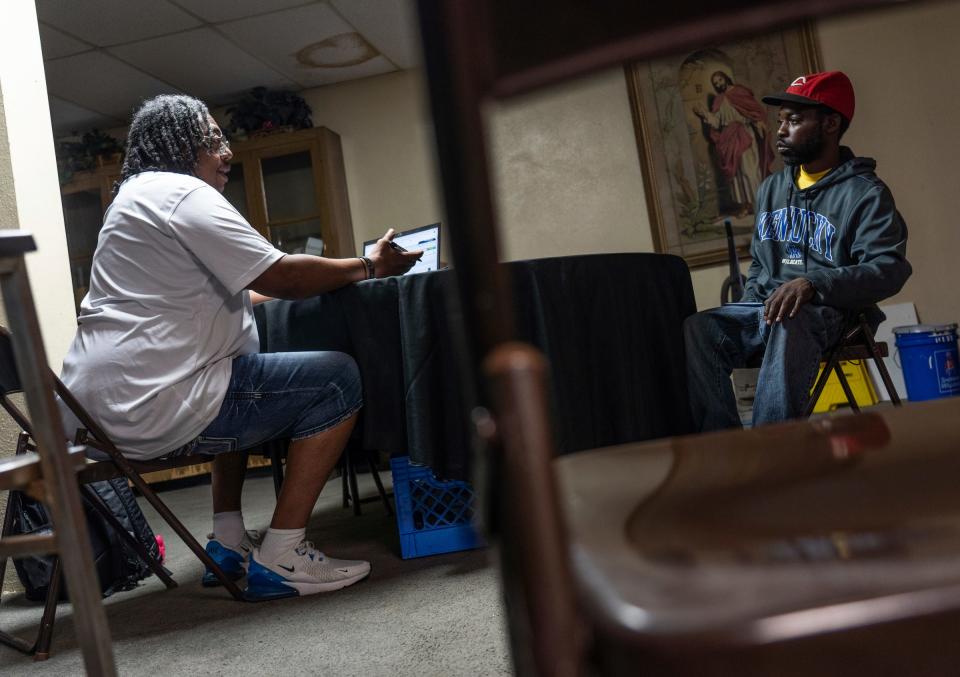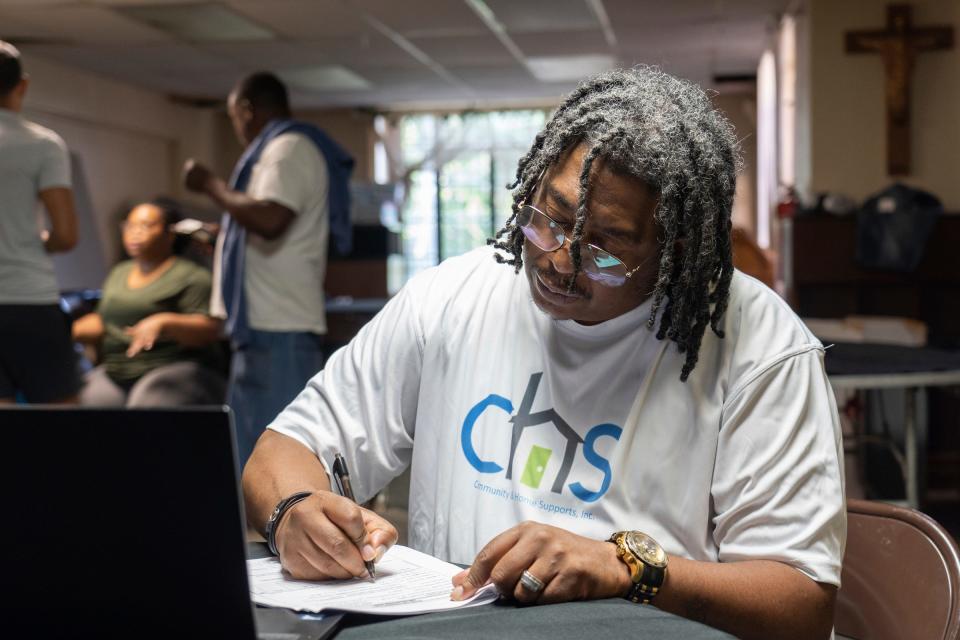'Dehumanizing experience': What new operators of homeless hotline hope to fix
When a person in Detroit, Hamtramck or Highland Park is experiencing homelessness, the primary way for them to get into shelters or access other housing help is through one hotline.
That hotline (313-305-0311), and the system behind it, is known as the Coordinated Assessment Model, or CAM. It's designed so people who need help go through one stop instead of trying multiple places for assistance. CAM has received sharp criticism from users who said phone wait times were long, and, in some cases, people waited for hours only to learn there was no place for them in a local shelter. They also say the hotline's operating hours are insufficient.
"Most people who are homeless, they're not homeless on business hours," said Chad Audi, president and CEO of the Detroit Rescue Mission Ministries, which takes referrals from CAM's hotline.
The criticism comes as the system is changing hands.
Southwest Solutions, which ran CAM for nearly a decade, decided last fall it will stop operating the system this summer as the nonprofit shifts its focus. Representatives from the shelters and nonprofits that serve homeless people through the hotline have chosen a new operator and aim to improve the system. Among their goals: resuming in-person assistance and ramping up trainings for how staff interact with clients.
Last summer, from July to September, CAM received more than 11,000 inquiries. The system is crucial in helping people find shelter and housing options, said Tasha Gray, executive director of the Homeless Action Network of Detroit (HAND), who chairs the CAM transition team.
"The first interaction that people experiencing homelessness have is usually with CAM and so that impacts how they flow through the rest of our system, with any provider that they're working with."
HAND will serve a three-year term as the lead agency, handling the administrative work. Also in the works is a proposed plan for HAND, the city of Detroit and the Wayne Metropolitan Action Agency to provide call center and in-person operations for CAM.
More: Detroit's 36th District Court to resume in-person eviction hearings starting June 5
More: Westland Housing Commission to open voucher waiting list. Here's what to know.
Here's a look at how CAM works, what users of the system had to say and what organizers hope to improve as it changes hands.

How does the system work?
The CAM system is what's known nationally as "coordinated entry," a streamlined way for people to access housing resources that are available. CAM has four main functions:
Provide access to shelters and services
Assess a person's housing needs
Identify and prioritize the most vulnerable clients
Refer people to housing programs for long-term assistance
The hotline is staffed 9 a.m. to 5 p.m. Mondays, Tuesdays and Wednesdays and 11 a.m. to 5 p.m. Fridays. Throughout the COVID-19 pandemic, in-person operations were available periodically, but were suspended in November, according to Southwest Solutions. It has been a phone service ever since.
In 2021, CAM conducted roughly 8,000 intakes, or 32 a day, according to its annual report. Of those, 4,857 were referred to a shelter and 1,146 were sent to overflow beds. About 2,000 were diverted, meaning CAM helped the household find a safe place to stay outside of shelters.
Once people are referred to a shelter through the CAM hotline, the nonprofit Community and Home Supports provides case management — meeting them at the shelter where they were placed, assessing their situation, gathering a client's documents to enroll in assistance programs, completing housing choice voucher applications and helping them get into permanent housing. Resource navigators go to various emergency shelters each week.
"I truly believe that the transition will result in a better system for people that will be more flexible, that will allow them to meet with people in person or over the phone," said Matthew Tommelein, coordinated entry programs manager for Community and Home Supports. "But I think that's one of the other reasons why our work is so important is because it's in person and it's not a one shot."
What do people who have sought help from CAM have to say about it?
People who've experienced homelessness pointed to long wait times, ranging from one to six hours on the phone and days to get a referral to shelter, according to a summary of feedback CAM's transition team gathered. Through focus groups, interviews and surveys earlier this year, the team received feedback from 106 people who have sought help through CAM.
Southwest Solutions, on May 26, said the wait time for CAM's hotline was 24 minutes.
Among other concerns clients raised: A CAM representative saying they would call a person but not following up, a shelter denying entry and people unaware of CAM when they first dealt with a housing crisis. The feedback also described clients not feeling heard or respected — a concern mentioned under a section titled "Dehumanizing experience." For in-person services, when CAM offered them, some people said they had to wait outside during extreme weather conditions. Others said they would arrive in the morning but had to wait all day to be assessed.
The summary included a version of the word "dehumanize" three times when describing feedback from people who used the system.
"We never want people who are utilizing our systems to feel dehumanized and so when that was brought up, it definitely hit home for us in that there are some opportunities for training for the staff who interact with the people who are experiencing homelessness. ... There is opportunity to show more empathy in a person's crisis," Gray said.
The feedback also points to instances when CAM worked. Clients said it was helpful to have multiple ways to access the system when CAM was available in person and over the phone. Some people reported successful interactions with CAM, in which staff "leaned in and helped problem solve barriers clients faced and this was deeply appreciated and very helpful," according to the summary.
In the future, clients said they want to see:
In-person, phone and virtual options to connect with CAM to make it more accessible.
Bus passes and vehicles to get people to and from any future in-person CAM intake locations and shelters.
For the hotline to be staffed 24 hours a day, seven days a week, or at least weekends and evenings
Shorter wait times
More advertising of the hotline in the community and more awareness about how the system works.
"This feedback reveals the significant need in the community and the lack of resources available to meet the immediate needs of homeless individuals and families. These responses are valid and require a response from the system," Jane Scarlett, Southwest Solutions' director of the housing resource center, said in a statement.
Audi, of Detroit Rescue Mission Ministries, said CAM needs to be a 24-hour service. He'd like to see quicker response times and support groups doing street outreach.
The transition of CAM to another operator is a time to reevaluate the needs of the community it serves, said Linda Little, president and CEO of the Neighborhood Service Organization, which gets referrals from CAM for emergency shelter. She said it's important for CAM to consider the medical and behavioral health histories of clients as they come through the system.
"Assessing the current needs of the population is first and foremost," she said. "There's a lot of unhoused residents that we don't count today. There's a transient population that's sleeping in abandoned homes, in their cars, couch surfing."
How is CAM changing?
Southwest Solutions has been the lead agency for CAM since 2014. However, last September, the nonprofit's leadership decided that it would give up that role after Aug. 31. The move is an organizational shift to focus on expanding affordable housing developments and permanent supportive and rapid rehousing programs, according to Southwest Solutions.
"The CAM takes a lot of energy and resources. It's a very large program with a lot of rules and regulations and it's a lot of work to run the program. It takes a lot of staff resources and really, we were able to redeploy our staff in a more meaningful way that we knew we would be able to if we weren't running the CAM," said Laura LeBlanc, executive director of philanthropy and communications at Southwest Solutions.

Southwest Solutions currently has $959,341, primarily through the U.S. Department of Housing and Urban Development (HUD), to operate CAM. Scarlett, in a statement, said the nonprofit had enough funding and staff to run the system. Still, the job was a complex one. Over time, CAM required Southwest Solutions to handle a growing list of extra duties she said. Governments and nonprofits sought data from CAM that required it to shift 30% of its staff to information management-related job responsibilities.
"It's not an easy job being a referral source for thousands of families in Wayne County. It's a lot of work and it's tough work with clients who need a lot of support," LeBlanc said.
So, what's next?
The administrative responsibilities of running CAM transfer to HAND on Sept. 1. Meanwhile, HAND, the city of Detroit and Wayne Metro are working on a proposal to collaborate on call center and in-person operations.
During this period of transition, the call line will be available and the hours are expected to remain the same, Gray said.
The majority of CAM funding comes from HUD and the city of Detroit. The ideal budget for the revamped system is $2.7 million a year, Gray said. So far, there's $2 million in the coffers, she said. If that gap isn't closed, CAM may have to roll back some improvements, such as in-person sites.
"At a bare minimum, the new lead agency should be providing services by Sept. 1," Gray said, with the understanding that flexibility is key since it's a heavy lift to transfer technology and funding between agencies within a short time span.
The goal is "as little disruption as possible," she said, and to get back to in-person services because that's what helps staff connect with clients and get them the resources they need.
Contact Nushrat: nrahman@freepress.com; 313-348-7558. Follow her on Twitter: @NushratR. Sign up for Bridge Detroit's newsletter. Become a Free Press subscriber.
This article originally appeared on Detroit Free Press: Detroit's homeless hotline receives criticism, new management
